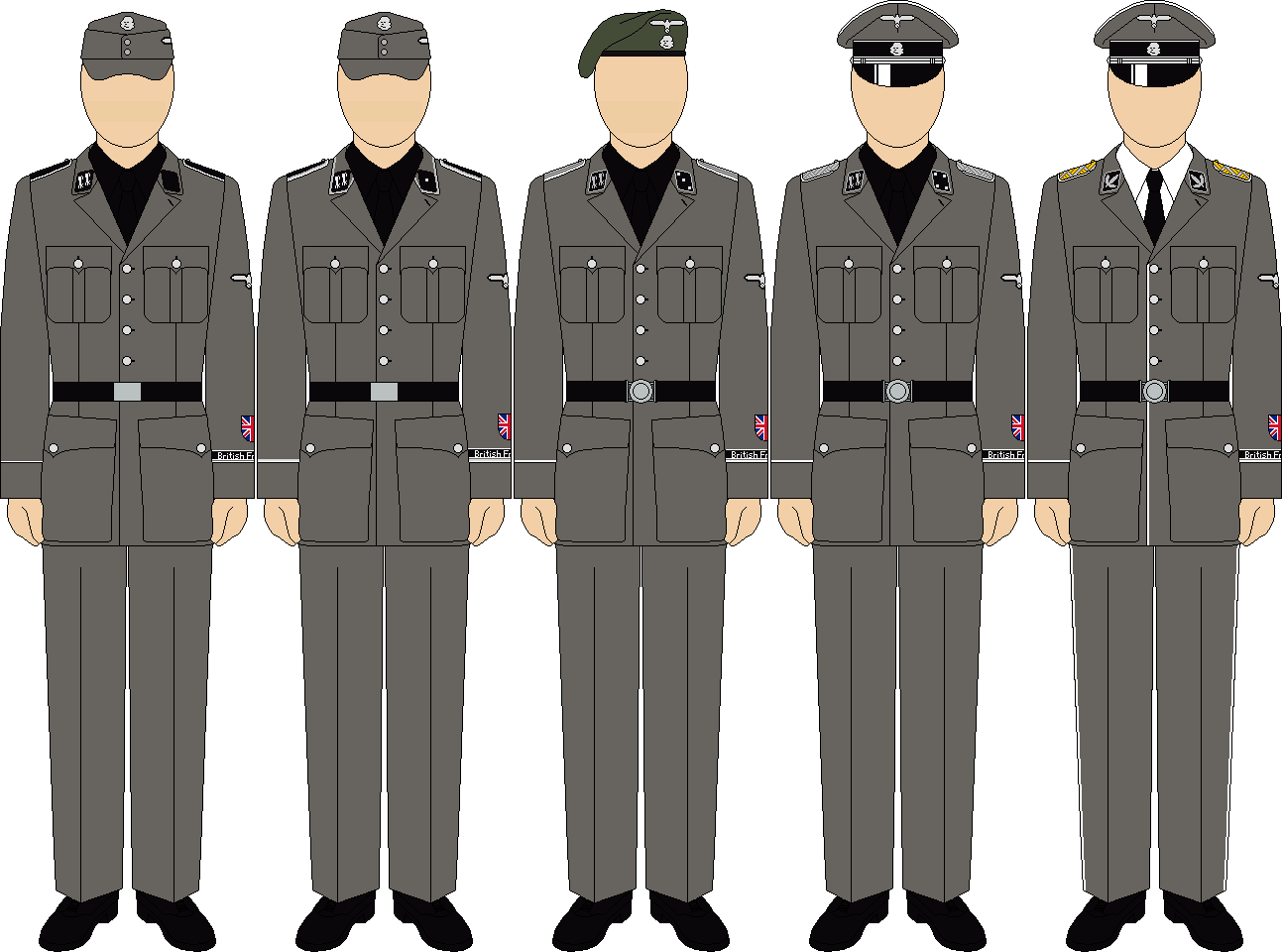The British Free Corps is an Infantry and Airmobile Division of the Waffen-SS which recruits from the United Kingdom and the Irish Republic. It was formed 1944 from British and Commonwealth prisoners of war. It reached platoon strength by the time of the Armsitice, but had grown little since then Until 1950, joining the British Free Corps was technically illegal under British law. The Foreign Services Act 1950 allowed Britons to serve in foreign armies provided the British Government approved of the army in question.
During 1950, the British Free Corps gained a permanent base in Hildesheim, near the St. Michaeli Kloster, and appointed its first senior British officer, SS-Obersturmbannfuhrer Gregory Wilkes, who had previously served with the Parachute Regiment. Wilkes had been cashiered out of the British Army for making public political comments favouring Fascism. While the British Government was in a transition to a pro-Fascist, then an outright Fascist regime, it expected the Army to remain apolitical.
Colonel Wilkes envisaged an elite infantry unit, and even suggested that part of the unit be parachute-qualified. Wilkes was fanatical about physical training, and proscribed high standards of fitness. The Germans had suggested separate units for Englishmen, Scots, Welsh, and Irishmen, but Wilkes refused. He believed that the men would work and fight better as mixed units. A recruiting office was established in London, and an recruit training base was set up in Wales, near the Brecon Beacons. Wilkes gently eased out the wartime members of the British Free Corps. Wilkes wrote "these ex-prisoners are low types. They joined for women and beer. Anyway, one can't trust a traitor, even if his treason benefits you. I shall exclude anyone who collaborated with the Germans during the war."
The first intake filled the German's expectations in terms of numbers. The rising Cold War tensions meant that the Germans needed men soon. Training proceeded quickly on the Brecon Beacons. The men who signed on were subjected to intensive tests of their endurance, and physical fitness. Wilkes requested harsh instructors. In addition to a group of ex-British Army Sergeant Majors, SS recruit instructors were seconded to the British Free Corps. Unlike the British Army, there was very little "square bashing". When on the parade square, the BFC practices standard-British Army drill.
The British Free Corps reached division strength by 1958. The British Free Corps became the 39th SS Infantry Division. It had two conventional infantry brigades, and an airmobile brigade with an enlarged helicopter allocation. The BFC's aviation units are part of the National Socialist Flyer's Corps.
During the 1978 reorganisation of the Waffen-SS, the British Free Corps was re-designated 22nd SS Infantry Division British Free Corps. The British Free Corps is generally used as a quick reaction force for operations outside Western Europe. The BFC is often used to provide support for Germany's allies. A battalion is permanently stationed in French Guiana to help the French Government guard the European Space Agency site at Kourou.
The British Free Corps is under the command of SS-Gruppenfuhrer Alex Miles.
Organisation[]
The British Free Corps is a fairly unique division. It has two infantry Brigades, and Airmobile Brigade, a Divisional Artillery Brigade, a Divisional Aviation Brigade, a Combat Support Brigade, and a Services Brigade. The infantry brigades generally consist of four infantry battalions, a medium artillery battery, and a cavalry battalion with armoured cars. The BFC's airmobile brigade has three infantry battalions, a light artillery battery, and its cavalry battalion uses the Wiesel series of light tanks.
There are units not part of the 22nd SS Infantry Division that are still part of the British Free Corps. In the United Kingdom, training and administrative units to support the division are part of the BFC. BFC members also form the Feindkommandos der Waffen-SS, which simulates League of Democracies forces. The fact that English-speakers are used adds to realism. This unit is based in the Ukraine, where large training areas are available. BFC members may serve on secondment with other units. Contrary to popular belief, the BFC is not used to impersonate members of League of Democracies armies. Trials during the Vietnam War were unsuccessful due to the variation in the accents of English speakers from various countries. Differences that seemed minor to German ears were obvious to Canadian or Australian ears.
Equipment and Uniforms[]
Most combat equipment is standard Waffen-SS equipment. British Free Corps troops on training duties in the UK sometimes carry the British SA80 rifle. The Pistole 640(b) (Browning High Power) is often carried by officers in preference to the P 80 or P 38. The MP 750 (e) (Sterling SMG) is often used in preference to the German submachine guns.
The standard SS collar tabs are replaced by the three lions of England. The division's cuff title is "British Free Corps" written in gothic script. The SS eagle is replaced by a special British Free Corps eagle, in which the swastika is replaced by the flash and circle of the British Union of Fascists. This was authorised after the Battle of Ia Drang in the Vietnam War A union jack nationality patch is worn on the left arm. BFC troops also wear berets. The colours follow the British Army's practice. For example, infantry wear rifle green, artillery men wear navy blue, armoured vehicle operators wear black. Aviation personnel in the NSFK replace the swastika arm band with the British Union of Fascists armband. BFC personnel substitute black shirts for the white or blue shirts of the SS, and the brown shirts of the NSFK.
